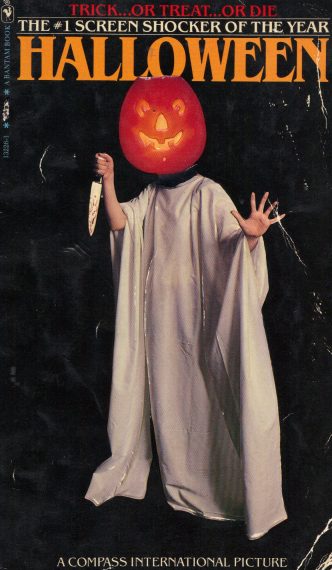 By CURTIS RICHARDS (Bantam; 1979)
By CURTIS RICHARDS (Bantam; 1979)
One of the most revered and widely sought-after movie novelizations, Curtis Richards’ HALLOWEEN went through multiple printings (and covers) throughout 1979. The movie, of course, is John Carpenter’s fabled HALLOWEEN, and this sprightly written novelization is so strong Carpenter actually used elements from it in his script for HALLOWEEN II.
One of the most revered and widely sought-after movie novelizations, Curtis Richards’ HALLOWEEN went through multiple printings (and covers) throughout 1979.
Richards wreaks some minor but crucial changes on Carpenter and Debra Hill’s HALLOWEEN screenplay. The soulless Michael Myers is here given a supernatural rationale for his psychosis, which is directly tied to the powers invoked by the ritual of Samhain, the Druid festival of the dead. The particulars of Samhain are laid out in a prologue, which also takes into account today’s more innocent celebration of All Hallows Eve, or Halloween. And yet, as Richards pointedly informs us, “from time to time, the innocent frolic of All Hallows Eve was shattered by some brutal and inexplicable crime, and the original spirit of the celebration was brought home to a horrified world.”
As we all know, HALLOWEEN begins with eight-year-old Michael Myers stabbing to death his older sister, for which he’s interred in a mental hospital for the next fifteen years. He breaks out to terrorize a bunch of teen babysitters before he’s finally brought down—or so it seems—by the determined Dr. Loomis.
The soulless Michael Myers is here given a supernatural rationale for his psychosis…
The film is marked by intricately constructed suspense. Cliff Richards never quite succeeds in replicating that suspense, but makes up for that lack with some profoundly impacting death scenes that really convey the horror and futility of Michael Myers’ insanity (“She could actually hear her mind contemplating the length and coldness of the long blade as it penetrated…in her last moment she was aware of a blend of surprise and regret that the event could be so peaceful and undramatic”).
The film is marked by intricately constructed suspense. Cliff Richards never quite succeeds in replicating that suspense, but makes up for that lack with some profoundly impacting death scenes
Richards also slyly comments upon the narrative’s occasional implausibility—“Nice going, Laurie, she said to herself. Why didn’t you just shout, “I’m in here, Mr. Murderer!”—and relates several sequences from Michael Myers’ point of view (whereas the film only contains one such sequence). While this novel overall is hardly a masterpiece for the ages, taken for what it is it’s damn fine, and very nearly a must-read.
“Nice going, Laurie, she said to herself. Why didn’t you just shout, “I’m in here, Mr. Murderer!”
